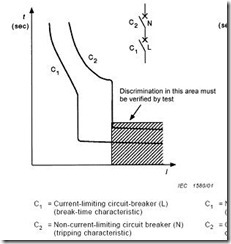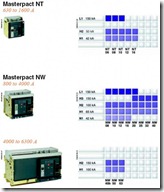Low Voltage Circuit Breakers
Circuit breakers are switching devices whose primary function is to isolate parts of an electrical distribution system in the even of abnormal conditions. Abnormal conditions are generally caused by faults on a system which can lead to dangerous situations for both people and the system itself. In addition to providing system protection, circuit breakers enable parts of the electrical distribution to be isolated for operation and maintenance.
This note is an introduction to some circuit breaker concepts and the application of circuit breakers to low voltage power systems. Low is defined as 1000 V and below.
Circuit Breakers
Circuit breakers are manufactured and tested in accordance with the IEC 60947 ‘Low-voltage switchgear and controlgear’ standard.
Types of circuit breaker
While Terminology varies quite, in general there are three general categories of circuit breaker commonly acknowledged:
 | Air Circuit Breaker (ACB) – typically larger circuit breakers, 630 A and above. Can either be fixed or withdrawal. Generally have a spring charging mechanism and have serviceable components. |
 | Moulded Case Circuit Breaker (MCCB) – lower rating circuit breakers, typically with frame sizes of 100 A and upwards. Integrated units, surrounded by a moulded case. |
 | Miniature Circuit Breaker (MCB) – small single or three phase circuit breakers from a few amps, typically up to 125 A. Commonly used for small power end circuits (socket outlets, lights, control power, etc.). |
Circuit Breaker Ratings
Circuit breakers are characterised by the ratings.
For ACB and MCCB, the operational rating of a circuit breaker is determined by it’s frame size and the trip rating of any protection unit. Frame sizes are standardised - 100 A, 160 A, 250 A, 400 A, 630 A, 800 A, 1000 A, 1250 A, 2000 A and 2500 A. Protection units determine the actual level at which the circuit breaker will trip and will vary depending on frame size and type of protection unit. As a typical example, thermal magnetic trip units for a 100 A frame, could be selected as 16 A, 25 A, 32 A, 40 A, 50 A, 63 A, 80 A or 100 A.
For MCB, the operational rating is typically fixed (i.e. one rating for each device).
For fault handling characteristics, the main ones are the ultimate short-circuit breaking capacity, service short-circuit breaking capacity
a breaking capacity, rated short-time withstand current and short-circuit breaking (or making) capacity. For more details on these , please refer to the following post:
Understanding LV Circuit Breaker Fault Ratings
Utilization categories
The utilization category of a circuit breaker related to if the device is intentionally designed to discriminate based on time or no. There are two categories:
A - not specifically intended for selectivity, with no integrated delay in tripping
B – intended for selectivity, with integrated delay in tripping
Frequently Asked Questions
On myElectrical, we have had some questions asked of circuit breakers. To answer these we put the questions to a well know circuit breaker manufacturer, Merlin Gerin (part of Schneider Electric). The answers below, are official answers from Merlin Gerin's technical support team.
Energy Discrimination
 Question - One column has ‘Inst 15' and the other ‘Inst OFF' and we assume that the associated data applies for each condition. The question is: does the ‘Inst 15' data apply only for an instantaneous setting of 15 or does it apply to all settings below 15.
Question - One column has ‘Inst 15' and the other ‘Inst OFF' and we assume that the associated data applies for each condition. The question is: does the ‘Inst 15' data apply only for an instantaneous setting of 15 or does it apply to all settings below 15.
Answer - Tables corresponding to " Inst:15" are exclusively available with this setting. In case you apply lower setting we cannot guarantee [[discrimination]].
Energy Discrimination & Zone Selectivity
 Question - Question phrased as an example:
Question - Question phrased as an example:
Using energy discrimination tables an upstream NT16H1 (with MicroLogic 6.0) will not provide total discrimination with a downstream NT16H1 (with MicroLogic 6.0). If we used [[zone selective interlocking]] on these two breakers would we be able to achieve total discrimination (or does the breaker current limiting characteristic override the zone interlocking).
Answer - The ZSI can give a discrimination only in "Short Time" and "Earth Fault" protection, but not for "Long Time" protection. For "Long Time" protection, you need to adjust the settings Ir and tr so that the downstream ACB will be tripped before the upstream ACB.
Question - Can you just confirm that by "Short Time" you mean the shaded area in the illustration?
Answer - The shaded area is for "Short Time" and "Instantaneous" protection for earth fault.
Masterpact NT & NW in China

 Question - Nearly everywhere MG Masterpact breakers consist of the NT and NW range. In China there are MT and MW breakers listed on the Schneider website. Please can you explain the differences?
Question - Nearly everywhere MG Masterpact breakers consist of the NT and NW range. In China there are MT and MW breakers listed on the Schneider website. Please can you explain the differences?
Answer - The differences are:-
- International offers:
- NT covers the range from 630A to 1600A
- NW covers the range from 800A to 6300A
- China PRC offers:
- MT covers the range from 630A to 6300A
- MW covers the range from 400A to 4000A
- In addition, there are differences in the breaking capacity.
Reflex Tripping
Question - Is the following understanding correct:
- In the ‘reflex tripping' region (see Compact catalogue pages 254 onwards) the circuit breaker will operate independently of any protection module (see reflex note on page 261).
- If a circuit breaker has a protection module installed and this is removed/disable (i.e. in an attempt to turn the breaker into an isolator), the ‘reflex tripping' action will still occur, cannot be disabled and the device will still trip at high fault currents.
- Zone Selective Interlocking (ZSI) overrides the reflex action, enabling discrimination between breakers of the same rating.
- It is not possible to override/disable the ‘reflex tripping' function (except maybe item 3 above).
Answer - The reflex tripping mechanism breaks the circuit at very high fault current, hence, it refers to short circuit condition.
- Correct
- Incorrect, ZSI cannot override reflex tripping
- It is not possible to disable the reflex tripping function